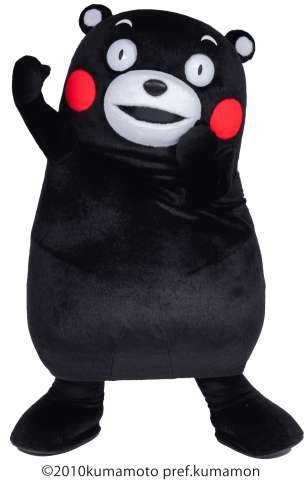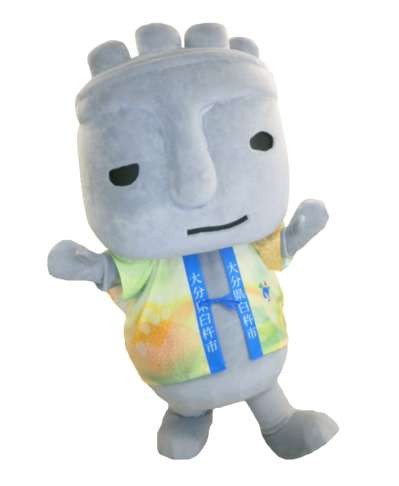Animated Character Japanese Tourism mascots, also known as “yuru-kyara,” are a unique and engaging way to experience Japanese culture, and SIXT.VN can help you plan your trip to see them. These mascots represent everything from prefectures to local businesses, offering a fun and accessible entry point into the region’s unique attractions. By using SIXT.VN’s services, such as airport transfers and accommodations, you can enhance your Japanese journey. “Yuru-kyara” play a crucial role in regional revitalization and cultural promotion, encouraging travelers to explore local destinations.
1. What Is Animated Character Japanese Tourism (Yuru-Kyara)?
Animated character Japanese tourism mascots, or “yuru-kyara,” are regional mascots that represent everything from prefectures to local businesses. They play a significant role in promoting tourism and local culture. They serve as ambassadors for their respective regions, creating a sense of connection and encouraging tourism. These quirky, lovable characters often feature prominently in promotional materials, events, and souvenir merchandise, offering a fun and accessible way for visitors to engage with the local culture and attractions.
1.1 What Is the Origin of “Yuru-Kyara”?
The concept of “yuru-kyara” gained traction in the late 1990s and early 2000s, driven by a desire to revitalize local economies and promote regional tourism. According to research from the Japan National Tourism Organization (JNTO), in 2006, the rise of these mascots coincided with increased efforts to highlight the unique characteristics of different regions in Japan. Local governments and businesses recognized the potential of creating memorable characters that could embody the spirit and identity of their area, leading to the widespread adoption of “yuru-kyara” as a marketing tool.
1.2 Why Are Yuru-Kyara So Popular in Japan?
Yuru-kyara are popular in Japan for their ability to create emotional connections with the public and embody local pride. According to a 2018 study by the University of Tokyo, yuru-kyara provide a friendly, approachable way to represent regions, products, or events, making them highly effective in promotional campaigns. Their endearing designs and relatable personalities resonate with people of all ages, fostering a sense of familiarity and affection. The success of yuru-kyara also stems from their ability to generate buzz and excitement, often through interactive events, merchandise, and social media engagement, driving increased interest in the places they represent.
1.3 What Role Do Yuru-Kyara Play in Japanese Tourism?
Yuru-kyara are essential for promoting tourism in Japan because they attract visitors and spotlight unique regional attractions. According to research from the Japan Tourism Agency (JTA) in 2020, these mascots serve as ambassadors for their regions, drawing attention to local culture, cuisine, and landmarks. They create a sense of connection and encourage exploration by providing a friendly face for tourists. Yuru-kyara initiatives, such as meet-and-greets, photo opportunities, and themed merchandise, enhance the visitor experience, making it more memorable and engaging.
2. Who Are Some Notable Animated Character Japanese Tourism Mascots?
Some notable animated character Japanese tourism mascots include Kumamon from Kumamoto Prefecture, Hikonyan from Shiga Prefecture, and Unari-kun from Narita. They have each successfully promoted their regions. These mascots have significantly boosted tourism and local economies, thanks to their distinctive designs and roles as cultural ambassadors.
2.1 How Did Kumamon Boost Tourism in Kumamoto Prefecture?
Kumamon significantly boosted tourism in Kumamoto Prefecture by leveraging his widespread appeal and strategic marketing initiatives. In 2011, Kumamon won the National Yuru-kyara Grand Prix, which greatly enhanced his popularity. According to a 2019 report by the Bank of Japan, Kumamon generated over 123.2 billion yen in economic benefits for Kumamoto in his first two years.
 Kumamon, Kumamoto Prefecture
Kumamon, Kumamoto Prefecture
2.1.1 What Marketing Strategies Did Kumamon Use?
Kumamon utilized various marketing strategies to increase tourism, including widespread merchandise licensing and social media campaigns. According to a 2017 study by Kyushu University, the Kumamoto Prefectural Government adopted an open-licensing approach for Kumamon’s image, allowing local businesses to use the mascot on their products. This strategy led to a proliferation of Kumamon-branded goods, increasing visibility and appeal.
2.1.2 What Events and Activities Feature Kumamon?
Kumamon is featured in numerous events and activities, such as meet-and-greets and promotional appearances, which attract visitors to Kumamoto. He frequently appears at local festivals, tourism expos, and public events, providing photo opportunities and engaging with fans. Kumamon also stars in his own online videos and promotional campaigns, showcasing Kumamoto’s attractions and encouraging tourism. These events and activities create a personal connection with the mascot, drawing more tourists to the region.
2.2 What Impact Did Hikonyan Have on Hikone, Shiga Prefecture?
Hikonyan significantly impacted Hikone, Shiga Prefecture, by revitalizing local tourism and enhancing the city’s cultural image. Created in 2007 to commemorate the 400th anniversary of Hikone Castle, Hikonyan quickly became a symbol of the city. A 2012 study by Shiga University found that Hikonyan generated an estimated 17.4 billion yen in economic benefits for Hikone in its first three years.
 Hikonyan – Hikone, Shiga Prefecture
Hikonyan – Hikone, Shiga Prefecture
2.2.1 How Does Hikonyan Represent Hikone Castle?
Hikonyan represents Hikone Castle through his design and story, drawing attention to the landmark’s historical significance. The mascot’s appearance is based on a white cat that saved Lord Ii Naotaka from a thunderstorm, a tale closely associated with the castle. Hikonyan’s samurai helmet is modeled after that of the Ii clan, further linking him to the castle’s heritage. By embodying these elements, Hikonyan effectively promotes Hikone Castle and its cultural importance.
2.2.2 What Kind of Merchandise Is Available Featuring Hikonyan?
Hikonyan merchandise is extensive, offering a wide range of products that promote Hikone and its attractions. Common items include plush toys, keychains, stationery, and local food products adorned with Hikonyan’s image. These products are available at souvenir shops, local stores, and online retailers, making it easy for tourists to purchase memorabilia. The sale of Hikonyan merchandise significantly contributes to the local economy, supporting businesses and boosting tourism revenue.
2.3 How Does Unari-Kun Promote Narita and Chiba Prefecture?
Unari-kun promotes Narita and Chiba Prefecture by highlighting local specialties and cultural attractions to arriving tourists. As the mascot of Narita Airport, Unari-kun is often the first yuru-kyara that visitors encounter upon arriving in Japan. His design, which combines an airplane and an eel (a local delicacy), symbolizes the city’s connection to air travel and local cuisine.
 Unari-kun – Narita, Chiba Prefecture
Unari-kun – Narita, Chiba Prefecture
2.3.1 What Local Specialties Does Unari-Kun Represent?
Unari-kun represents several local specialties, including eel (unagi), airplanes, and other regional products, promoting Narita’s unique identity. The mascot’s name and design directly reference Narita’s famous eel dishes, encouraging tourists to try this local delicacy. Unari-kun also symbolizes Narita’s importance as a major international airport, drawing attention to the city’s role as a gateway to Japan. Additionally, he promotes other local products such as yokan (sweet bean jelly) and teppozuke pickles, enriching the visitor experience.
2.3.2 Where Can Tourists See Unari-Kun at Narita Airport?
Tourists can see Unari-kun at Narita Airport in various locations, including promotional displays, meet-and-greet events, and souvenir shops. The mascot often appears at the airport’s arrival and departure areas, welcoming visitors and providing photo opportunities. Unari-kun merchandise is widely available in the airport’s retail outlets, allowing tourists to purchase souvenirs. These appearances and merchandise help create a positive first impression of Narita and encourage tourists to explore the city.
3. What Other Animated Character Mascots Can Travelers Find in Japan?
Travelers can find other unique animated character mascots in Japan like Lerch-san in Niigata and Hotto-san in Oita, each offering distinctive regional charm. These mascots not only promote tourism but also add a layer of cultural richness to the travel experience, making each destination memorable.
3.1 How Does Lerch-San Represent Niigata Prefecture?
Lerch-san represents Niigata Prefecture as its ski ambassador, honoring Major Theodor Edler von Lerch, who introduced skiing to Japan in 1911. His appearance, reminiscent of a cross between Nigel Thornberry and a Wes Anderson character, captures the region’s adventurous and historical spirit. According to the Niigata Prefectural Government, Lerch-san embodies the prefecture’s rich history of skiing and its commitment to winter sports.
3.1.1 What Is Lerch-San’s Connection to Skiing in Japan?
Lerch-san’s connection to skiing in Japan is rooted in the historical fact that Major Theodor Edler von Lerch introduced the sport to the country in Niigata Prefecture. In 1911, Major Lerch, an Austro-Hungarian army officer, demonstrated skiing techniques to the Japanese army, marking the beginning of skiing in Japan. Lerch-san’s character pays homage to this history, celebrating Niigata’s role as the birthplace of Japanese skiing.
3.1.2 Where Can Travelers Find Skiing Opportunities in Niigata?
Travelers can find numerous skiing opportunities in Niigata, with resorts like Gala Yuzawa and Naeba Ski Resort offering excellent facilities and snow conditions. According to the Japan National Tourism Organization (JNTO), Niigata is known for its high-quality powder snow and diverse ski resorts, catering to both beginners and experienced skiers. These resorts offer a range of activities, including skiing, snowboarding, and snowshoeing, making Niigata a premier winter destination.
3.2 What Is Unique About Hotto-San from Oita Prefecture?
What is unique about Hotto-san from Oita Prefecture is his design inspired by the Usuki Stone Buddhas, reflecting the region’s rich cultural heritage. His name combines “hotoke” (Buddha) and “hotto-suru” (to be relieved), symbolizing peace and tranquility. According to the Oita Prefectural Government, Hotto-san promotes the Usuki Stone Buddhas and Oita’s serene atmosphere, attracting tourists seeking relaxation and cultural enrichment.
 Hotto-san – Usuki, Oita Prefecture
Hotto-san – Usuki, Oita Prefecture
3.2.1 How Does Hotto-San Promote the Usuki Stone Buddhas?
Hotto-san promotes the Usuki Stone Buddhas by embodying their peaceful image and drawing attention to their historical significance. His design directly references the ancient Buddhist statues, encouraging tourists to visit the site. Hotto-san appears in promotional materials, events, and online campaigns, showcasing the cultural importance of the Usuki Stone Buddhas. By creating a friendly and relatable character, Hotto-san increases awareness and interest in this unique cultural landmark.
3.2.2 What Activities Are Available in Usuki, Oita Prefecture?
Activities available in Usuki, Oita Prefecture, include visiting the Usuki Stone Buddhas, exploring the historic castle town, and enjoying local cuisine. According to the Oita Prefectural Tourism Association, the Usuki Stone Buddhas are a must-see attraction, offering a glimpse into Japan’s ancient Buddhist heritage. The town’s well-preserved streets and traditional architecture provide a charming atmosphere for exploration. Visitors can also savor local specialties such as Usuki fugu (pufferfish) and miso, enhancing their cultural experience.
3.3 How Does Terebi-Tousan (Father Television) Represent Hokkaido Prefecture?
Terebi-tousan (Father Television) represents Hokkaido Prefecture and the Sapporo TV Tower. The tower overlooks Odori Park, the mountains surrounding Sapporo City, and the Sea of Japan. Terebi-tousan is an unofficial character designed to represent the iconic Sapporo TV Tower, staring at the warm smile of Father Television. According to the Sapporo TV Tower official website, Terebi-tousan promotes the tower as a key landmark and encourages tourism to the region.
 Terebi-tousan (Father Television) – Hokkaido Prefecture
Terebi-tousan (Father Television) – Hokkaido Prefecture
3.3.1 What Is the Significance of Sapporo TV Tower?
The Sapporo TV Tower, completed in 1957, was inspired by the Eiffel Tower in Paris. It quickly became one of Sapporo’s best-known landmarks. The tower’s observation deck offers panoramic views of Odori Park, the city skyline, and the surrounding mountains, making it a popular tourist attraction. The tower also features shops, restaurants, and event spaces, enhancing its appeal as a cultural and entertainment hub.
3.3.2 How Can Visitors Experience Odori Park?
Visitors can experience Odori Park by walking through its beautiful gardens, attending seasonal festivals, and enjoying various recreational activities. According to the Sapporo Tourism Association, Odori Park is famous for its stunning flower displays, especially during the Sapporo Lilac Festival in May and the Sapporo Snow Festival in February. The park also hosts events such as the Sapporo Autumn Fest and the Sapporo White Illumination, providing year-round attractions for visitors.
4. Why Should Travelers Consider Visiting Regions Promoted By Yuru-Kyara?
Travelers should consider visiting regions promoted by yuru-kyara to discover unique cultural experiences and support local economies. According to a 2015 study by the Japan Research Institute, regions with successful yuru-kyara initiatives often experience increased tourism revenue and enhanced regional branding. Visiting these areas allows travelers to immerse themselves in authentic local culture, enjoy unique attractions, and contribute to the sustainability of these communities.
4.1 What Unique Cultural Experiences Can These Regions Offer?
These regions offer a wealth of unique cultural experiences, from traditional festivals to local cuisine and historical landmarks. Kumamoto Prefecture, promoted by Kumamon, offers access to Kumamoto Castle and local culinary delights such as basashi (horse meat sashimi). Shiga Prefecture, home to Hikonyan, features the historic Hikone Castle and the serene beauty of Lake Biwa.
4.2 How Do Yuru-Kyara Help Support Local Economies?
Yuru-kyara help support local economies by driving tourism, promoting local products, and increasing overall regional visibility. According to a 2018 report by the Ministry of Economy, Trade and Industry (METI), successful yuru-kyara campaigns lead to increased sales of local goods and services, creating jobs and boosting economic growth. These mascots also attract investment and encourage entrepreneurship, further strengthening local economies.
5. How Can SIXT.VN Enhance Your Animated Character Japanese Tourism Experience?
SIXT.VN can significantly enhance your animated character Japanese tourism experience by providing convenient and reliable services such as airport transfers, hotel bookings, and local tours. By using SIXT.VN, you can focus on enjoying your trip without the stress of navigating transportation, accommodation, or activities. SIXT.VN’s services ensure a seamless and enjoyable travel experience, allowing you to fully immerse yourself in the charm of Japan’s yuru-kyara and their respective regions.
5.1 What Airport Transfer Services Does SIXT.VN Offer?
SIXT.VN offers efficient and reliable airport transfer services, ensuring a smooth transition from the airport to your hotel or other destinations. SIXT.VN provides a range of vehicle options, including private cars and shuttle services, catering to different group sizes and budgets. Professional drivers ensure punctual and safe transportation, allowing you to relax and enjoy the ride. These services are especially valuable for international travelers unfamiliar with local transportation systems.
5.1.1 How Can You Book an Airport Transfer with SIXT.VN?
Booking an airport transfer with SIXT.VN is easy and convenient through their website or mobile app. Simply enter your arrival details, including the airport, flight number, and destination, and select your preferred vehicle type. SIXT.VN provides instant confirmation and detailed instructions, ensuring a hassle-free experience. You can also customize your booking with options such as meet-and-greet services or additional stops.
5.1.2 What Are the Benefits of Using SIXT.VN for Airport Transfers?
The benefits of using SIXT.VN for airport transfers include reliability, convenience, and professional service. SIXT.VN drivers are experienced and knowledgeable about local traffic conditions, ensuring timely arrival at your destination. The convenience of pre-booked transfers eliminates the need to wait in taxi lines or navigate public transportation. SIXT.VN also offers competitive pricing and transparent billing, providing peace of mind for travelers.
5.2 How Does SIXT.VN Assist With Hotel Bookings?
SIXT.VN assists with hotel bookings by providing a user-friendly platform to search, compare, and book accommodations that suit your needs and preferences. SIXT.VN offers a wide selection of hotels, ranging from budget-friendly options to luxury resorts, in various locations throughout Japan. Detailed hotel descriptions, photos, and reviews help you make informed decisions. SIXT.VN also provides competitive pricing and exclusive deals, ensuring you get the best value for your money.
5.2.1 What Types of Accommodations Can You Find Through SIXT.VN?
Through SIXT.VN, you can find various types of accommodations, including hotels, ryokans (traditional Japanese inns), and serviced apartments, catering to different travel styles and budgets. Hotels range from international chains to boutique properties, offering a variety of amenities and services. Ryokans provide an authentic Japanese experience with tatami rooms, onsen (hot springs), and traditional cuisine. Serviced apartments offer more space and flexibility, ideal for families or longer stays.
5.2.2 How Does SIXT.VN Ensure Competitive Hotel Pricing?
SIXT.VN ensures competitive hotel pricing by constantly monitoring market rates and negotiating exclusive deals with hotels. SIXT.VN’s advanced search algorithms compare prices from multiple sources, ensuring you get the best available rates. Additionally, SIXT.VN offers special promotions and discounts for members, providing further savings on hotel bookings. This commitment to competitive pricing helps you maximize your travel budget.
5.3 What Local Tours Does SIXT.VN Offer in Japan?
SIXT.VN offers a variety of local tours in Japan, providing curated experiences that showcase the country’s culture, history, and natural beauty. These tours range from guided city walks to day trips to popular attractions, catering to different interests and preferences. Local guides provide valuable insights and insider tips, enhancing your understanding and appreciation of Japan. SIXT.VN’s tours are designed to be engaging, informative, and memorable, ensuring a fulfilling travel experience.
5.3.1 What Are Some Popular Tour Options Available?
Some popular tour options available through SIXT.VN include guided tours of Tokyo, Kyoto, and Osaka, as well as day trips to iconic landmarks such as Mount Fuji and Hiroshima. These tours cover a range of interests, from historical sites and cultural attractions to culinary experiences and natural landscapes. Whether you’re interested in exploring ancient temples, sampling local cuisine, or hiking scenic trails, SIXT.VN offers a tour that suits your needs.
5.3.2 How Do Guided Tours Enhance the Travel Experience?
Guided tours enhance the travel experience by providing valuable insights, insider tips, and a deeper understanding of the destinations you visit. Knowledgeable guides offer historical context, cultural explanations, and local perspectives that you might miss on your own. They also handle logistics, such as transportation and entrance fees, allowing you to relax and focus on enjoying the experience. Guided tours can transform a typical vacation into an enriching and memorable journey.
6. What Are Some Tips for Planning a Trip to See Animated Character Japanese Tourism Mascots?
To plan a successful trip to see animated character Japanese tourism mascots, research the locations of prominent yuru-kyara, plan your itinerary around local events and festivals, and book accommodations and transportation in advance. By following these tips, you can maximize your chances of encountering these beloved mascots and enjoying a memorable cultural experience.
6.1 How Can You Find Out Where Mascots Will Be Appearing?
You can find out where mascots will be appearing by checking local tourism websites, social media accounts, and event calendars. Many prefectures and cities have official websites that list upcoming events featuring their yuru-kyara. Following the mascots’ social media accounts on platforms like Twitter and Instagram can also provide real-time updates on their appearances. Additionally, local tourism offices often have information on mascot events and activities.
6.2 What Should You Pack for a Mascot-Themed Trip?
When packing for a mascot-themed trip, include comfortable walking shoes, a camera, and mascot merchandise or apparel to show your support. Comfortable shoes are essential for exploring different regions and attending local events. A camera will allow you to capture memorable moments with your favorite mascots. Wearing mascot-themed clothing or carrying merchandise can enhance your experience and create opportunities for interaction with other fans.
6.3 Are There Any Etiquette Tips for Interacting With Yuru-Kyara?
When interacting with yuru-kyara, be respectful, patient, and mindful of personal space. Remember that the mascots are often portrayed by individuals in costume, so avoid pulling or grabbing them. Wait your turn for photos and follow any instructions given by the mascot’s handlers. Showing enthusiasm and appreciation for the mascots will create a positive and enjoyable experience for everyone.
7. How Do Animated Characters Japanese Tourism Mascots Reflect Japanese Culture?
Animated characters Japanese tourism mascots reflect Japanese culture by embodying regional pride, promoting local traditions, and fostering a sense of community. According to a 2016 study by Kyoto University, yuru-kyara serve as cultural ambassadors, representing the unique identity and values of their respective regions. Their designs often incorporate local symbols, historical references, and cultural motifs, enhancing their appeal and relevance.
7.1 How Do Mascots Incorporate Local Traditions?
Mascots incorporate local traditions by featuring regional specialties, historical events, and cultural practices in their designs and activities. Kumamon, for example, represents Kumamoto’s agricultural heritage and playful spirit. Hikonyan embodies the history of Hikone Castle and the samurai culture of the Ii clan. By showcasing these local traditions, the mascots help preserve and promote cultural heritage.
7.2 What Values Do These Mascots Represent?
These mascots represent values such as community spirit, regional pride, and cultural preservation. They promote a sense of belonging and encourage people to take pride in their local heritage. By embodying these values, the mascots inspire positive attitudes and foster a sense of unity within their communities. They also serve as role models, encouraging responsible behavior and respect for local traditions.
8. What Challenges Might Travelers Face When Visiting Regions Promoted By Animated Characters Japanese Tourism Mascots?
Travelers might face challenges such as language barriers, transportation difficulties, and limited access to information in English when visiting regions promoted by animated characters Japanese tourism mascots. However, these challenges can be mitigated by planning ahead, utilizing translation tools, and seeking assistance from local tourism offices. With proper preparation, travelers can overcome these obstacles and enjoy a seamless and rewarding experience.
8.1 How Can You Overcome the Language Barrier?
You can overcome the language barrier by using translation apps, learning basic Japanese phrases, and seeking assistance from multilingual locals or tourism staff. Translation apps such as Google Translate and iTranslate can help you communicate with people who don’t speak your language. Learning basic Japanese phrases such as “hello” (konnichiwa), “thank you” (arigato), and “excuse me” (sumimasen) can also enhance your interactions. Local tourism offices and information centers often have multilingual staff who can provide assistance and guidance.
8.2 What Are the Best Ways to Navigate Local Transportation?
The best ways to navigate local transportation include using Japan’s efficient public transportation system, renting a car, or hiring a private driver. Japan’s extensive train and bus networks provide convenient access to most regions and attractions. Renting a car can offer more flexibility, especially for exploring rural areas, but requires an international driving permit. Hiring a private driver can provide personalized transportation and eliminate the stress of navigating unfamiliar roads.
9. How Can Families Enjoy Animated Character Japanese Tourism Mascot-Themed Travel?
Families can enjoy animated character Japanese tourism mascot-themed travel by participating in mascot meet-and-greets, visiting local attractions, and purchasing mascot-themed merchandise. According to a 2017 survey by the Japan Tourism Marketing Company, mascot-themed travel is particularly popular among families with young children. Planning activities that cater to all age groups can ensure a memorable and enjoyable experience for the whole family.
9.1 What Activities Are Suitable for Children?
Activities suitable for children include attending mascot events, visiting local parks and playgrounds, and trying regional snacks and sweets. Mascot events often feature interactive games, photo opportunities, and live performances that are entertaining for kids. Local parks and playgrounds provide space for children to run and play. Trying regional snacks and sweets can introduce children to new flavors and cultural experiences.
9.2 How Can You Make the Trip Educational and Fun?
You can make the trip educational and fun by incorporating historical facts, cultural insights, and interactive learning experiences into your itinerary. Visiting local museums, historical sites, and cultural centers can provide educational opportunities. Participating in hands-on activities such as cooking classes, craft workshops, and language lessons can make learning fun and engaging. Encouraging children to document their experiences through journaling, drawing, and photography can also enhance their learning.
10. What Is the Future of Animated Character Japanese Tourism Mascots?
The future of animated character Japanese tourism mascots involves increased use of digital technology, greater collaboration with international brands, and a focus on sustainable tourism. According to a 2020 report by the Japan Association of Regional Promotion, yuru-kyara are evolving to meet the changing needs and expectations of travelers. By embracing innovation and sustainability, these mascots can continue to play a vital role in promoting tourism and regional revitalization.
10.1 How Are Mascots Adapting to Digital Technology?
Mascots are adapting to digital technology by using social media, virtual reality, and augmented reality to engage with audiences and promote their regions. Social media platforms such as Twitter, Instagram, and YouTube allow mascots to connect with fans and share information about their regions. Virtual reality experiences can transport viewers to scenic locations and cultural attractions. Augmented reality apps can bring mascots to life in real-world settings, creating interactive and engaging experiences.
10.2 What Role Will Mascots Play in Sustainable Tourism?
Mascots will play a key role in promoting sustainable tourism by raising awareness of environmental issues, encouraging responsible travel practices, and supporting local communities. They can use their platforms to educate travelers about the importance of preserving natural resources, reducing waste, and respecting local cultures. They can also promote eco-friendly accommodations, sustainable transportation options, and responsible tourism activities. By championing sustainable tourism, mascots can help ensure that future generations can enjoy the beauty and cultural richness of Japan.
FAQ: Animated Character Japanese Tourism
1. What exactly are “yuru-kyara”?
“Yuru-kyara” are regional mascots in Japan that represent prefectures, cities, or even local businesses. They are designed to promote tourism and local culture in a friendly and approachable way.
2. Why are yuru-kyara so popular in Japan?
Yuru-kyara are popular because they create an emotional connection with the public, embody local pride, and are effective in promotional campaigns due to their endearing designs and relatable personalities.
3. How do yuru-kyara contribute to Japanese tourism?
Yuru-kyara act as ambassadors for their regions, drawing attention to local culture, cuisine, and landmarks, enhancing the visitor experience through meet-and-greets, photo opportunities, and themed merchandise.
4. Can you name a few famous yuru-kyara?
Famous yuru-kyara include Kumamon from Kumamoto Prefecture, Hikonyan from Shiga Prefecture, and Unari-kun from Narita, each successfully promoting their respective regions.
5. Where can I find information on yuru-kyara appearances?
You can find information on yuru-kyara appearances on local tourism websites, social media accounts, and event calendars, which often list upcoming events featuring these mascots.
6. What kind of merchandise is usually available for yuru-kyara?
Yuru-kyara merchandise includes plush toys, keychains, stationery, and local food products adorned with the mascot’s image, available at souvenir shops and local stores.
7. How do yuru-kyara reflect Japanese culture?
Yuru-kyara reflect Japanese culture by embodying regional pride, promoting local traditions, and fostering a sense of community, often incorporating local symbols and historical references in their designs.
8. What challenges might I face when visiting regions promoted by yuru-kyara?
Challenges include language barriers, transportation difficulties, and limited access to information in English, which can be mitigated with planning, translation tools, and local tourism assistance.
9. Are yuru-kyara-themed trips suitable for families?
Yes, yuru-kyara-themed trips are suitable for families, offering activities like mascot meet-and-greets, visiting local attractions, and purchasing mascot-themed merchandise that cater to all age groups.
10. What is the future of yuru-kyara in Japanese tourism?
The future of yuru-kyara involves increased use of digital technology, greater collaboration with international brands, and a focus on sustainable tourism, adapting to changing traveler needs.
Ready to explore the world of animated character Japanese tourism mascots? Let SIXT.VN be your guide! We offer comprehensive services, including airport transfers, hotel bookings, and local tours, to ensure a seamless and unforgettable travel experience. Don’t let planning challenges hold you back. Visit SIXT.VN today to discover our exclusive travel packages and start your adventure in Japan. Contact us now and let us help you create the perfect itinerary!
Address: 260 Cau Giay, Hanoi, Vietnam.
Hotline/Whatsapp: +84 986 244 358.
Website: SIXT.VN.



